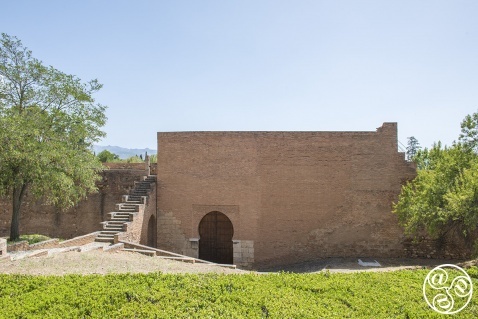
Remnant of the palace aqueduct. |
|
alhambra alta - high alhambra
We enter the Alhambra from the Generalife Gardens by the bridge called Puente Nuevo. However, the original route of access, in Moorish times, between the Alhambra and the Generalife went through the Puerta del Hierro, the Iron Gate, and made it necessary to cross the ravine on foot. When the Alhambra obtained national monument status in 1870, this route was replaced, for the comfort of the visitors, by the "new bridge".
Parallel to the bridge runs the much more ancient and now disused aqueduct of the Alhambra. In the 13th century, the founding Sultan, Alhamar, built an acequia or water channel along the slopes of the River Darro, drawing its water miles upstream to supply first the Generalife and then the Alhambra Palace. Here, the channel spanned the ravine to enter the Alhambra. The ruins of the Torre del Agua - Water Tower - destroyed by the French troops at the end of the War of Independence, looms in the background.
We can still see a segment of the Acequia Real, the "Royal Channel", inside the palace walls, where it was broken to make way for the footpath leading from the bridge down to the Nasrid Palaces.
As we walk down the footpath from the bridge, we see on our left a gate in the wall called Puerta de los Siete Suelos - the Gate of the Seven Floors, or Levels. It is so called because it was originally protected by a larger external gate, similar to the Puerta de la Justicia, which had seven "steps".
The last Sultan of Granada, Boabdil, used this gate when he rode out to present his surrender to the Catholic Monarchs in the winter of 1491, and one of the conditions he demanded - and one of the very few which the Monarchs were to honour - was that this gate be sealed up forever, after the shameful day.
The city of the Alhambra - medina al-Hamrat - was excavated in the 19th century, revealing the foundations of luxury homes, some of which had their own baths.
Further down the hill are the remains of the palace of the rebellious Abencerraje family, whose male members were massacred by Sultan Muley Hassen.
Next page > Monastery of San Francisco
Buy your copy of - Granada, City of My Dreams
 Granada, City of My Dreams: An Historical and Artistic Guide to Granada and its Moorish Palace the Alhambra
Granada, City of My Dreams: An Historical and Artistic Guide to Granada and its Moorish Palace the Alhambra
This itinerary was written for Andaluca.com by Lawrence Boheme author of “Granada, City of My Dreams”. For, what fascinates us about this universal city is not only its monuments but its marvellous story, “the encounter between Moor and Christian, gypsy and Jew, medieval and Renaissance, glistening snow and Mediterranean sun. Lawrence Bohme, poet, illustrator and curious traveller, has filled these pages with luminous descriptions and drawings, the culmination of forty years of wanderings through the palaces and labyrinths. Amazon.co.uk or Amazon.es




